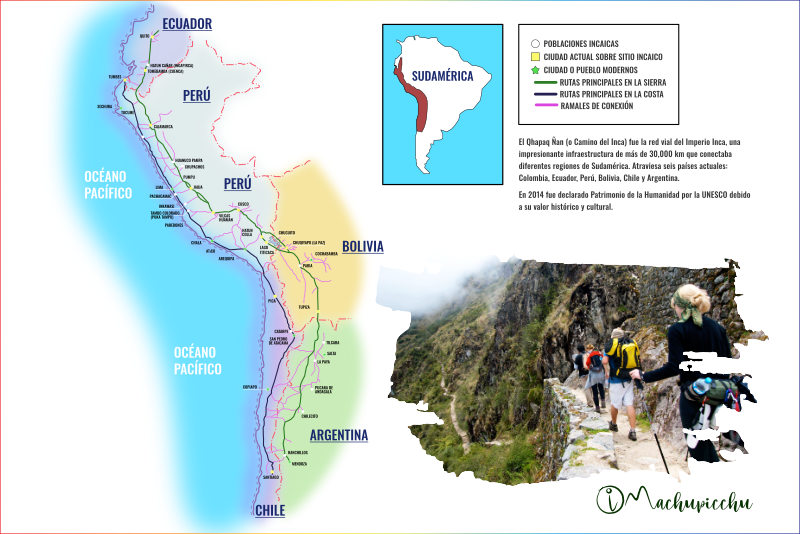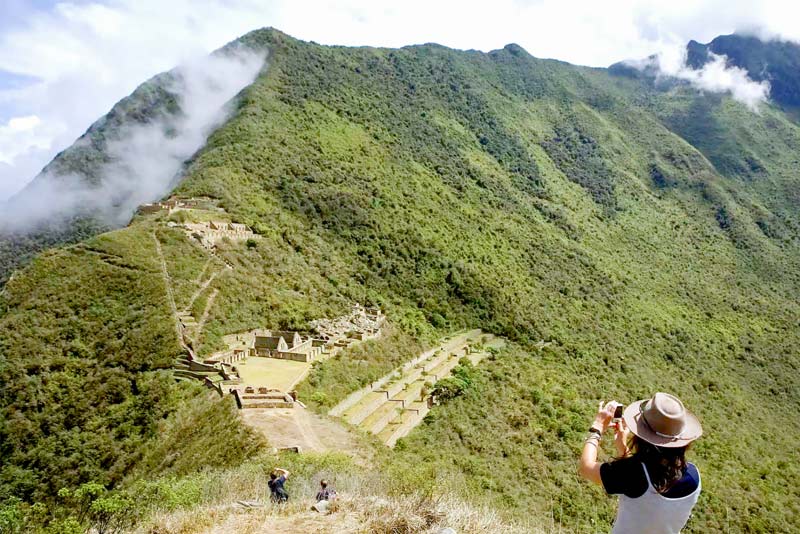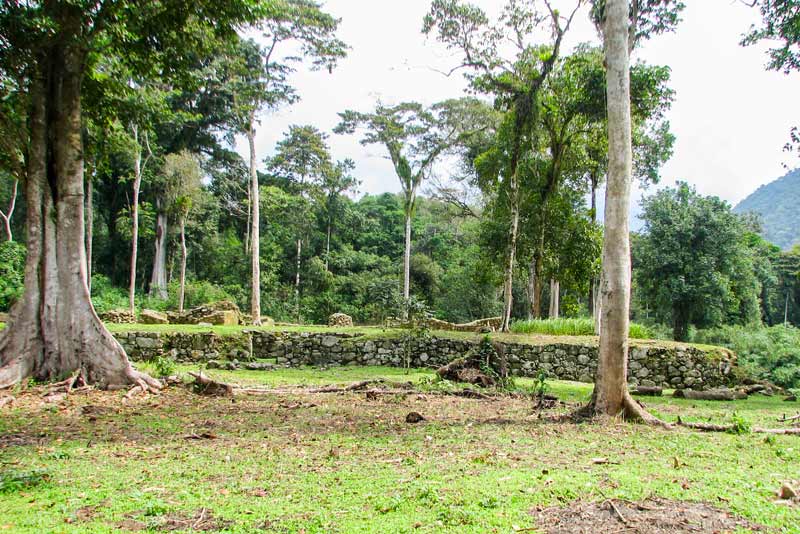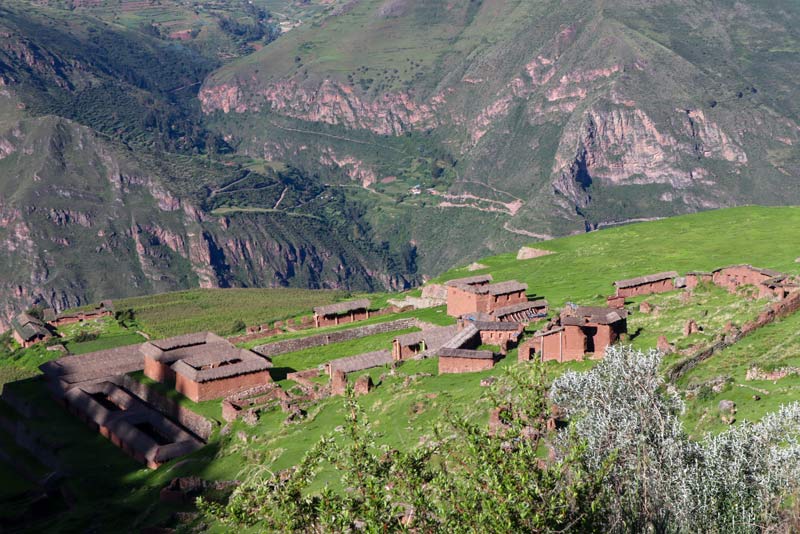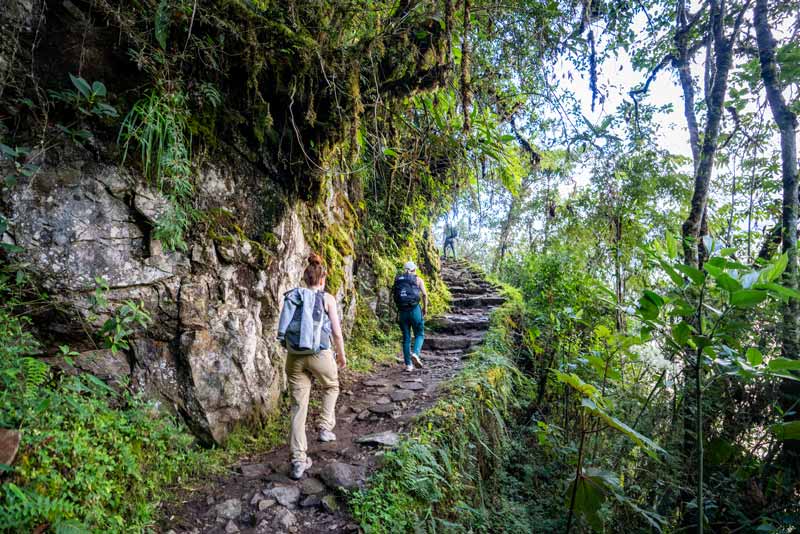Treks along Cusco’s most popular Inca trails
Throughout Cusco, we’ll find several networks of historic trails built by the Incas. These paths, known as “Qhapac Ñan,” will take us to incredible destinations. They also combine adventure with the significance of their legacy, making them ideal for planning your Cusco travel itinerary. Learn more about these legendary trails and the tourist attractions you’ll find after exploring them.
- The Inca Trails (Qhapac Ñan)
- Comparative table of the main routes of the Inca Trail
- When is the best time to hike in Cusco?
- Tips and recommendations
- Frequently Asked Questions
The Inca Trails (Qhapac Ñan)
The Inca trail network, known as Qhapac Ñan in Quechua, is a network of natural stone paths that remain in use today, more than 500 years later. This system of trails stretched for over 30,000 kilometers, spanning the countries of Peru, Bolivia, Argentina, Ecuador, Chile, and Colombia. These nations, which by region once formed the Tahuantinsuyu empire, were once part of the Inca Empire.
Along the Inca trails, we can find many bridges, tunnels, walls, stairways, and causeways that facilitated access to difficult sections, some in the middle of the jungle, others on the edges of canyons and mountains.
These trails connected not only regions but also the main Inca cities. It is also known that there were approximately 291 archaeological sites along their entire length. Today, these historic paths allow us to visit sites of great importance. Among the most important and best-preserved are the following:
Choquequirao Trek (8 days)
Immersing yourself in such an extensive adventure can be the adventure of a lifetime, although there are also shorter treks (4 days) that only take you to Choquequirao. This 8-day route takes you along some of the lesser-traveled Inca trails, in addition to exploring the two most important and best-preserved Inca citadels, Machu Picchu and Choquequirao.
The adventure involves traveling more than 90 kilometers along trails with stretches from 1,900 meters (Hidroeléctrica) to 4,600 meters (Paso Yanama). Five days of camping, along with two more days at a lodging facility, are also regularly scheduled.
Vilcabamba Trek (7 days)
Vilcabamba is known as the last capital of the Inca resistance, which is why it is also known as Espíritu Pampa. These trails will take you through stories of rebellion and fortitude, from Cusco to Espíritu Pampa and a final stop in Quillabamba.
During the Vilcabamba trek, we’ll encounter ecological regions of Quechua, Suni, Puna, Rupa Rupa, and the jungle brow. In addition, regarding altitude, we’ll encounter sections ranging from 500 to 3,860 meters above sea level.
It’s a lesser-known and rarely traveled adventure that covers almost 70 kilometers and allows you to explore trails steeped in stories that seem to whisper their entire legacy to you.
Inca Trail (4 days)
The most popular and impressive Inca Trail is the Inca Trail, an adventure that ranks among the best in the world. This trek covers approximately 41 kilometers, passing through some of Peru’s most breathtaking landscapes.
The adventure involves three days of camping, where we will visit impressive archaeological sites such as Llactapata, Runkurakay, Sayacmarca, Phuyupatamarca, Wiñay Wayna, Inti Punku, and our final destination, Machu Picchu. The altitude of the trail varies between 2,100 and 4,200 meters above sea level, although most of the journey will pass through jungle forests, where the humidity will be more noticeable than the altitude.
Inca Trail Restrictions
Access to the Inca Trail is only possible through an authorized tour agency like ours, whether for a 2- or 4-day tour. This is implemented by the Cusco Ministry of Culture to better monitor visitors and to ensure better care and maintenance of these historic trails. Remember to book your experience at least three months in advance, no matter the time of year.
Huchuy Qosqo Trek (2 days)
A shorter adventure, compared to the previous ones, on the route to Huchuy Qosqo from Tambomachay in Cusco. This tour takes you to one of the least-visited archaeological sites, but with the best panoramic views of all, located at the top of a mountain in the Sacred Valley.
The route covers nearly 19 kilometers, crossing high altitudes (up to 4,300 meters above sea level) and natural destinations such as Coricocha Lagoon, Quellecocha Lagoon, the Pucamarca Canyon, and views of the Pitusiray snow-capped mountain.
During the hike, we’ll cross stone bridges, stairways, stone gateways, and landscapes filled with biodiversity. Upon reaching Huchuy Qosqo, we’ll camp and explore it in more detail the following day.
Comparative table of the main routes of the Inca Trail
| Main routes | Approximate extension | Countries | Main regions | Characteristics |
|---|---|---|---|---|
| Trunk Route (Cusco – Quito) | 6,000 kilometers | Peru, Ecuador, Colombia | Cusco, Abancay, Cajamarca, Quito | It is the longest and most symbolic route, as it connected the center of Tahuantinsuyo (Cusco) with the north, crossing Andes, jungles, and mountainous moorlands. |
| Collasuyo Route (Cusco – Tucumán) | 4,000 kilometers | Peru, Bolivia, Argentina, Chile | Cusco, Puno, La Paz, Salta, Tucumán | It headed south of the empire. It crossed the high plateau and connected it with Aymara and Quechua peoples. |
| Antisuyo Route (Cusco – Amazon) | 300 – 500 kilometers | Peru | Cusco, Quillabamba, jungle edge | I was heading towards the jungle, it is a route fragmented by the jungle and the complicated geography. |
| Contisuyo Route (Cusco – Arequipa – Moquegua) | 1,500 kilometers | Peru | Cusco, Arequipa, Moquegua | It was headed towards the southern coast, with routes to pre-Inca coastal ports and cultures. |
| Chinchaysuyo Route (Cusco – Quito) | 6,000 kilometers (included in the Trunk route) | Peru, Ecuador, Colombia | Cusco, Cajamarca, Quito, Pasto | It is the north of the empire, it is similar to the Troncal route, but it also connected with the northern Peruvian coast and with the Moche and Chimú cultures. |
When is the best time to hike in Cusco?
The Cusco region has two distinct seasons, both lasting the same amount of time, so it’s easy to plan your trip based on your climate preferences and some external factors.
- Rainy season (November to March): During this season in Cusco, we’ll find the greatest chance of rain, with very cloudy skies and landscapes. Therefore, we should always be prepared, throughout every tour, with waterproof clothing or at least a poncho, which tends to be in high demand during this season. However, it also has its positive side, as it’s the season with the fewest visitors and the time of year when you’ll see much greener landscapes due to the vegetation.
- The dry season (April to October): This is typically the most popular season for visitors, as it generally offers clear landscapes and blue skies during the day, ideal for visiting any of Cusco’s tourist destinations. However, your reservations should be made well in advance; demand increases, as does the number of visitors. Also, remember to dress extra warmly during this time, as temperatures drop significantly. (The best time to visit Machu Picchu)
Tips and recommendations
If you’re looking to explore the most impressive Inca trails in Cusco, we’ll provide you with a series of tips and recommendations that will help you have a better travel experience and be much better prepared when planning and traveling.
- To undertake any of these adventures along the Inca Trails, remember to be in good physical condition, since many of them involve multi-day hikes. This will help you avoid any complications.
- During your first few days of travel in Cusco, you should plan your itineraries lightly to avoid altitude sickness. Traveling to the Sacred Valley and staying at lower altitudes will help a lot.
- Book your Inca Trail experience at least three months in advance to ensure your experience on this unforgettable route.
- If your trip to Cusco is planned during the rainy season (November–March), you should prepare with waterproof clothing or a rain poncho, as the weather can be rainy at any time.
- During the dry season (April to October), you’ll find Cusco’s climate is more stable and clear, making it ideal for any of these tours.
- Hiking in Cusco will give you a different perspective on its popular attractions, and you’ll also be able to delight in dreamy landscapes, including mountains, snow-capped mountains, valleys, and jungle regions.
- The Huchuy Qosqo route can also be completed in just one day, although camping at the top offers starry skies and one of the most beautiful panoramic views in all of Cusco.
- The Inca Trail is closed during the month of February for maintenance, and it is also the rainiest month in Cusco.
- Many of the routes presented have variations that involve fewer days; you can check out all the available options on our website.
- Remember that you can book any experience in Cusco with Boletomachu Picchu. Ask our advisors about all the options available to make your trip unforgettable.
Frequently Asked Questions
1) What is the best time to hike the Inca Trail in Cusco?
The best time to visit is during the dry season, which runs from April to October. This is when you’ll find sunny days, clear skies, and better trail conditions.
2) Is it necessary to book the Inca Trail in advance?
Yes, we recommend booking at least 3 or 4 months in advance, especially if you’re traveling between May and August.
3) What is the difference between the Inca Trail and other treks like Choquequirao or Vilcabamba?
The Inca Trail is the most famous and culminates in Machu Picchu, passing through several archaeological sites. Choquequirao and Vilcabamba are longer, less-traveled routes that immerse you in rarely seen landscapes.
4) Which of the routes is the most physically demanding?
The Choquequirao Trek is often considered one of the toughest due to its distance, uneven terrain, and long days of hiking. Vilcabamba also requires considerable endurance.
5) How do I prepare physically for these walks?
It’s best to start walking more often and exercising to strengthen your legs. We also recommend acclimatizing to Cusco to avoid altitude problems.
6) What archaeological attractions are visited on the Inca Trail?
On the Inca Trail you will find sites such as Llactapata, Runkurakay, Sayacmarca, Phuyupatamarca, Wiñay Wayna and Inti Punku before reaching Machu Picchu.
7) How safe are the hikes on these Inca trails?
The trails are safe if you go with certified guides and agencies like ours. It’s not recommended to venture out on your own, especially on lesser-known trails like Vilcabamba or Choquequirao.
8) What treks can I do if I only have a few days in Cusco?
If you’re short on time, we recommend Huchuy Qosqo, which is ideal for a short getaway and offers stunning views of the Sacred Valley.
9) What are the four regions of Tahuantinsuyo?
Along the Inca trails we will find sections of the ancient regions of Tahuantinsuyo, such as Antisuyo, Collasuyo, Chinchaysuyo and Contisuyo.
10) Which countries were included in the Tahuantinsuyo empire?
The Tahuantinsuyu empire covered some regions of Peru, Bolivia, Argentina, Colombia, Ecuador and Chile.
Advice from people who have been there
 By: Roman R.
By: Roman R.“A magical night“
“I camped near the archaeological complex and it was an incredible experience. The starry sky there is amazing, but it is quite cold at night, so I recommend bringing a good sleeping bag and thermal clothing. There are no toilets nearby, so it is important to bring everything you need: water, snacks and flashlight. I also suggest arriving in time to set up the tent in daylight.“
By Ticket Machu Picchu – Last updated, July 18, 2025
